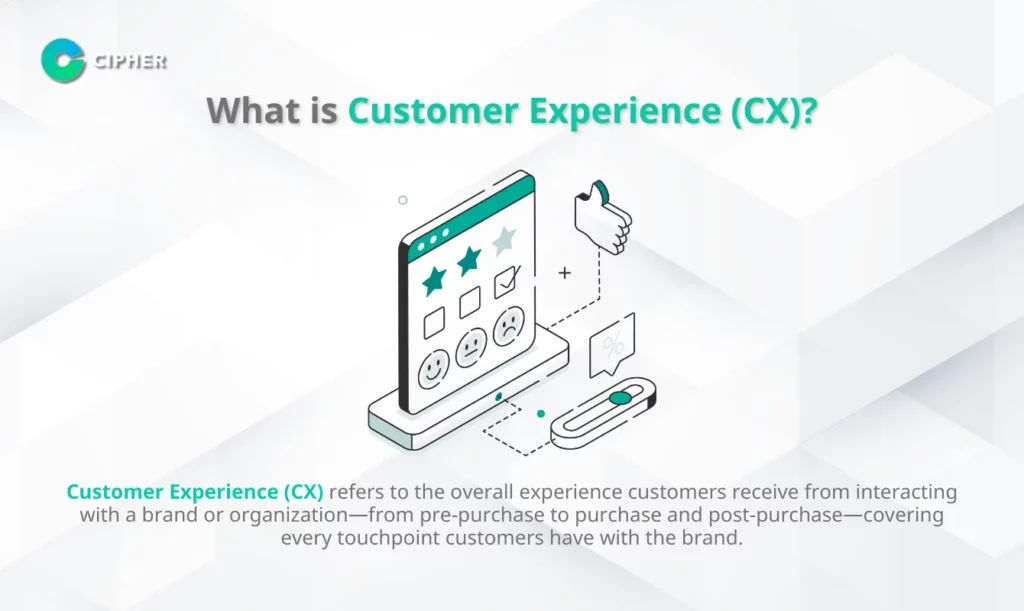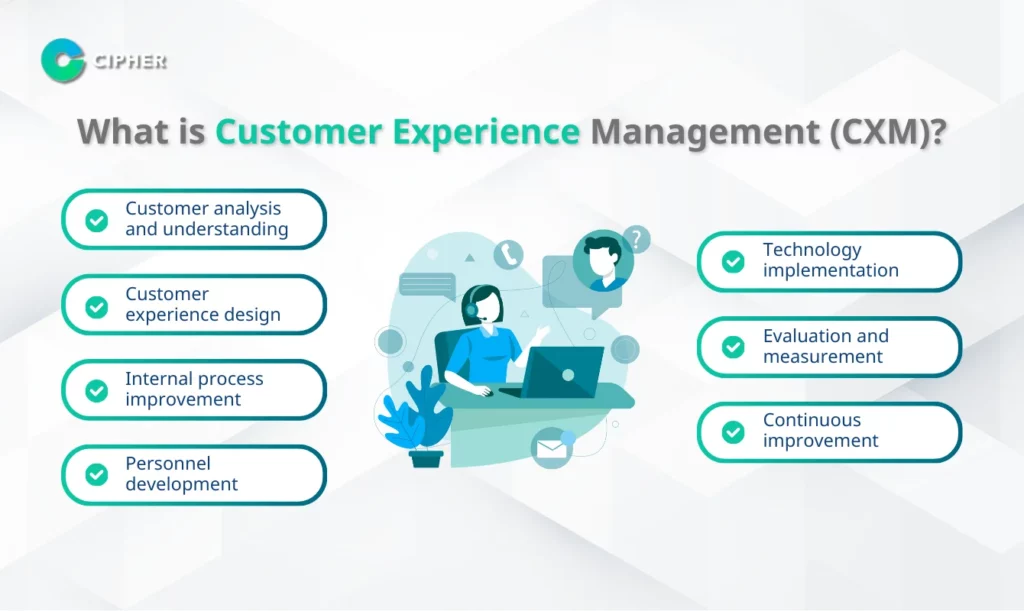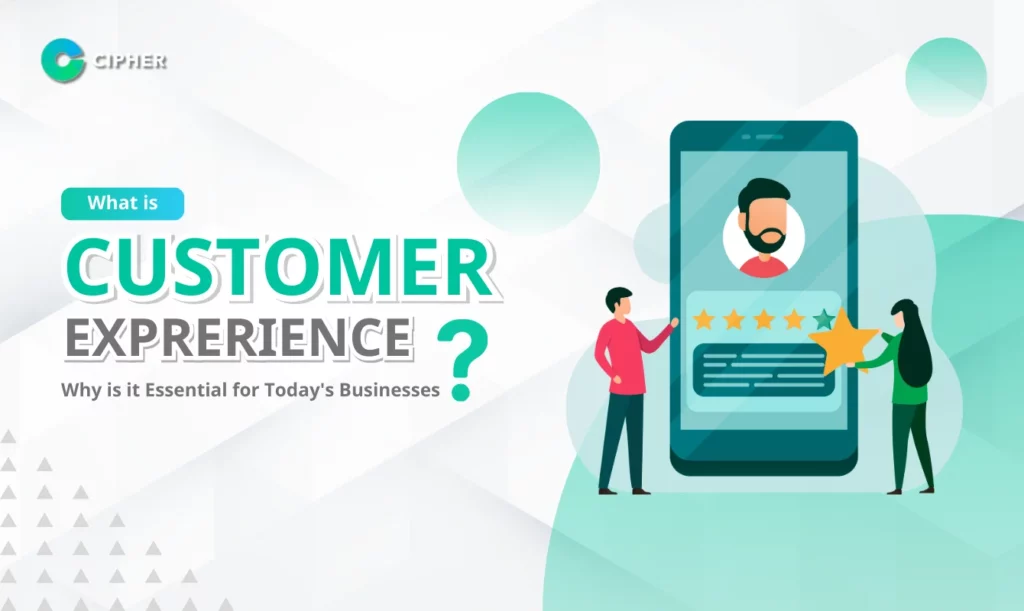Table of Contents
What is Customer Experience (CX)?

Customer Experience (CX) refers to the overall experience customers receive from interacting with a brand or organization—from pre-purchase to purchase and post-purchase—covering every touchpoint customers have with the brand.
Philip Kotler, the father of modern marketing, offers an interesting comparison of Customer Experience: it’s like a customer watching a great movie in a theater and being so impressed that they want to tell others about it, buy memorabilia, or even watch it again, collect the Blu-ray, or wait to watch it legally online. This is an example of the best service experience.
CX is not limited to customer service but is a broader overview consisting of these key components:
- Product and service experiences – Product quality, features, after-sales service
- Interaction experiences – Communication with staff, ordering processes, payment methods
- Channel experiences – Stores, websites, applications, social media
- Emotional experiences – Impressions, satisfaction, or disappointment
- Image and perception experiences – Customer perceptions of the brand
How Customer Experience Differs from Customer Service and User Experience (UX)
Many people confuse the terms Customer Experience (CX), Customer Service, and User Experience (UX), but these three concepts have different meanings and scopes:
Customer Experience (CX) vs. Customer Service: Customer Service refers to providing service to customers during the service period, including before and after using the service. It’s just one part of the overall Customer Experience. Another difference is that Customer Service typically focuses on solving problems, answering questions, and providing direct assistance to customers.
Customer Experience (CX) vs. User Experience (UX): User Experience (UX) refers to the user’s experience with products, such as the aesthetic appeal and ease of use of websites or applications. Meanwhile, Customer Experience (CX) is broader, including experiences before and after usage.
Why Customer Experience is Important for Today's Businesses
In an era where customers have numerous choices, business competition is fierce, and information is easily accessible, Customer Experience has become a crucial factor affecting business success. Customer Experience Marketing is unavoidable for brands aiming for sustainable growth. Consider these interesting statistics:
- 70% of consumers choose to switch brands for better quality products (Forbes)
- 81% of customers will switch to another brand due to poor customer service (WalkerInfo)
- 56% of customers will share negative experiences with others (WalkerInfo)
- 48% of consumers are willing to pay more for better customer service quality (Forbes)
Additionally, creating a good Customer Experience benefits businesses in several ways:
- Increased sales and revenue – Customers with positive experiences tend to buy more and more frequently
- Brand loyalty – Impressed customers are more likely to return for repeat business
- Word-of-mouth marketing – Satisfied customers will recommend the brand to others, which is more valuable than advertising investments
- Lower customer acquisition costs – Customer retention costs 5-25 times less than acquiring new customers
- Differentiation from competitors – In markets where products and services are similar, good experiences create differentiation
According to research by Zendesk, investing in customer experience has a direct impact on a company’s bottom line and long-term growth potential.
Core Elements of Customer Experience
Creating a good Customer Experience requires focusing on key elements that marketing teams should prepare for:
- Customer needs and expectations data – Study and understand what customers want and expect
- Personalization Marketing – Individualized marketing that addresses the needs of each customer
- Ease of access – Make it convenient for customers to access information and contact channels
- Consistency – Maintain standards of service and good experiences continuously
- Creating emotional connections – Make customers feel emotions such as fun, excitement, or appreciation
These elements work in harmony with marketing mix principles to create a comprehensive approach to customer satisfaction.
What is Customer Experience Management (CXM)?

Customer Experience Management (CXM or CEM) involves systematically managing customer experiences to create satisfaction and impressions for customers. It focuses on designing and delivering the best experiences at every touchpoint between customers and the brand.
CXM includes these important steps:
- Customer analysis and understanding – Study data, behavior, and customer needs
- Customer experience design – Create experiences that meet expectations and create impressions
- Internal process improvement – Develop processes that align with the desired experience
- Personnel development – Build skills and service consciousness in employees
- Technology implementation – Enhance service efficiency and convenience through technology
- Evaluation and measurement – Continuously monitor and measure customer experiences
- Continuous improvement – Use evaluation results for ongoing improvements
Effective CXM often requires enterprise-level content management systems to deliver consistent experiences across multiple channels.
7 Key Components of Customer Experience Management
For effective Customer Experience Management, there are 7 key components:
- Customer Insight – Deeply understand customer needs and behaviors to clearly visualize the Customer Journey
- Personalization – Deliver specific experiences to each customer by analyzing data and customer segmentation
- Consistency across all channels – Build confidence and seamless experiences across all channels, both online and offline (Omnichannel)
- Research & Development – Continuously check, measure, and improve customer experience strategies
- Innovation & Technology – Efficiently use technology to create good experiences for customers, such as CRM systems, Contact Centers, Chatbots
- Customer Satisfaction – Create emotional connections with customers, not just meeting functional needs but creating memorable experiences
- Employee Engagement – Develop and motivate employees to deliver great experiences to customers
How to Create a Good Customer Experience
Creating a good Customer Experience is a key to business success in today’s era. Here are important strategies to help you understand how to create impressive customer experiences:
- Understand customer needs – Study behavior, listen to opinions, and learn customers’ true needs
- Develop seamless experiences – Enable customers to contact, order, and receive services smoothly through any channel
- Provide timely and quick service – Respond to questions and customer needs quickly to show you value their time
- Train employees to have skills and a service focus – Develop employees to be professional, enthusiastic, and able to solve problems effectively
- Implement technology – Use digital technology to increase convenience and efficiency in service, such as appropriate CMS systems, chatbots, and applications
- Create diverse communication channels – Open channels for customers to easily contact, inquire, and express opinions
- Listen to customer feedback and continuously improve – Survey opinions, analyze suggestions, and improve products or services
Implementing professional social media management is particularly effective for monitoring customer sentiment and engaging with your audience in real-time.
6 Causes of Poor Customer Experience
While creating a good Customer Experience is important, there are several causes that can worsen the customer experience, which businesses should avoid:
- Over-reliance on automated responses – Using automated response systems too much can frustrate customers when they need to talk to actual staff
- Long waiting times – Making customers wait too long for callbacks due to insufficient staff
- Poorly trained staff – Employees without proper training may show negative emotions to customers
- Not understanding customer needs – Staff unable to understand and respond to customers’ true needs
- Ineffective problem-solving methods – Recommending solutions that don’t work, disappointing customers
- One-size-fits-all service – Providing the same service to everyone without considering specific customer needs
Customer Experience Measurement Tools
Measuring the success of Customer Experience creation is important to know if strategies are working well and what areas need improvement. Popular measurement tools include:
- Customer Effort Score (CES) – Measures how easy or difficult it is to use a service or solve a problem; higher scores indicate customers find it easy to use
- Net Promoter Score (NPS) – Measures the likelihood that customers will recommend the brand to others with questions like “How likely are you to recommend us to friends or acquaintances (0-10)?”
- Customer Satisfaction Score (CSAT) – Directly measures customer satisfaction with questions like “Are you satisfied with our service?” or satisfaction ratings
- Time To Resolution (TTR) – Measures the time taken to resolve customer issues; faster is better
Examples of Brands Successful in Creating Customer Experience
Disney
Disney stands out in creating impressive experiences for customers with strategies such as:
- Creating exciting atmospheres and experiences – Designing theme parks and resorts filled with charm and detailed decorations
- Convenient online booking and ticketing systems – Saving time and facilitating customers
- Attention to small details – Such as allowing customers to take photos with characters and mascots, and having facilities to accommodate all customer groups
- Excellent service – Employees trained to serve with smiles and friendliness
- Safety – Strict security measures and systems
Continuous improvement and development – Constantly developing and improving experiences
Netflix
Netflix uses Customer Experience strategies focusing on understanding each customer’s needs:
- Analyzing customer insights – Studying what content each customer likes to watch
- Recommending appropriate content – Analyzing data to recommend movies or series customers might like
- Creating specific feeds – Displaying interesting content for each customer on their feed
7 Interesting Customer Experience Statistics
These statistics will help you understand the importance of Customer Experience and trends businesses should pay attention to:
- Challenges in understanding customers – 22% of business leaders admit that understanding customer needs is difficult, and another 21% find adapting to rising expectations challenging (HubSpot)
- AI’s role in Customer Experience – 86% of Customer Experience leaders believe AI will help elevate experiences delivered to customers, and 77% expect AI will be able to communicate with most customers without staff by 2025 (HubSpot)
- Customers prefer self-service channels – 55% of customers want to use self-service channels such as knowledge bases or chatbots for quick problem resolution (HubSpot)
- Importance of personalized communication – 46% of customers look for personalized communication across multiple touchpoints (HubSpot)
- Expectations for problem resolution – 67% of customers expect problems to be resolved within 3 hours, with 21% expecting immediate resolution, 23% willing to wait up to one hour, and another 23% willing to wait up to 3 hours (HubSpot)
- Connecting all channels – 79% of survey respondents confirm that being ready to serve across all channels customers use is important (HubSpot)
- Customer retention and loyalty building – 31% of Customer Service leaders give highest priority to customer retention and customer loyalty (HubSpot)
Preparing for Customer Experience Implementation
Before starting Customer Experience Management, you should prepare in various areas:
- Understand target audience behavior – Listen to all customer opinions through various channels, including social media, surveys, and staff who communicate directly with customers
- Plan work clearly – Review business objectives clearly so that Customer Experience aligns with the main business goals
- Operate systematically – Focusing on:
Touch points – Channels where customers contact the brand
Interactions – Quality of communication between staff and customers
Engagement – Opportunities to create impressions for customers - Measure systematically – Use these indicators:
CSAT (Customer Satisfaction Score) – Customer satisfaction scores
NPS (Net Promoter Score) – Score of likelihood that customers will recommend the brand to others - Create transparency for the brand – Transparency leads to credibility; customers look for brands with ethics and understanding that align with them
Impact if Businesses Ignore Customer Experience
Neglecting Customer Experience can have serious negative effects on businesses in many areas:
- Loss of customers – Customers who receive bad experiences typically don’t return and tell others about their bad experiences
- Reputation damage – Reviews and complaints on social media have high destructive power; just a few posts can destroy long-established reputations
- Financial loss – Businesses must spend enormous amounts to fix reputations and attract new customers
- Lost opportunities – Competitors who prioritize Customer Experience will seize opportunities to take your customers
- Unhappy employees – Employees must face angry, complaining customers, affecting their mental state and work efficiency
Customer Experience Management Systems
Today, various technologies and systems help businesses manage Customer Experience efficiently, with options suitable for different businesses:
- CRM (Customer Relationship Management) systems – Help collect customer data, analyze behavior, and build good relationships
- Chat Management systems – Help answer questions, provide consultation, and solve problems for customers through chat channels like LINE OA, Facebook Messenger
- Omnichannel systems – Connect all contact channels together to create seamless experiences for customers
- Contact Center systems – Central hubs for communicating with customers, helping create impressions and quickly solve problems
- Chatbot systems – Use AI to answer questions and provide basic customer assistance, reducing staff workload and providing 24-hour service
Customer Experience Services Businesses Should Prioritize
If you’re considering improving Customer Experience in your business, there are key services to prioritize:
- Efficient CRM system – For systematic customer data collection and analysis
- Membership and point collection systems – To build loyalty and stimulate repeat purchases
- Multi-channel customer service (Omnichannel) – So customers can conveniently contact through preferred channels
- AI technology and Chatbots – To answer questions and serve customers 24 hours a day
- Voice of Customer collection and analysis – To understand customer needs and opinions
- Employee training – To ensure employees have good skills and attitudes in customer service
- Development of easy-to-use applications and websites – So customers can conveniently access information and services
- Creating CX testing and measurement programs – To continuously evaluate and improve customer experiences
Conclusion: Why Focus on Customer Experience?
Customer Experience (CX) is a key to creating differentiation and business advantage in today’s highly competitive era. Creating good customer experiences requires understanding customer needs, designing seamless experiences, using technology appropriately, and continuous development.
Businesses that prioritize CX can create satisfaction, loyalty, and word-of-mouth from customers, which is a worthwhile investment that generates long-term sustainable returns. For comprehensive customer experience solutions, partnering with experienced digital agencies can help accelerate your CX transformation journey.
Frequently Asked Questions
What is the role of Customer Experience?
What are examples of CEM?
What are the CX processes?
Customer Experience (CX) Development Approach:
- Listen: Ask for opinions and suggestions from customers through various channels to understand their true needs and expectations
- Understand: Analyze collected data to deeply understand customer behavior, preferences, and needs
- Fix: Use the data to improve products, services, and work processes to directly address customer needs
- Develop: Create good, impressive experiences that exceed customer expectations to differentiate from competitors
How can you create a good Customer Experience to sustainably maintain your customer base?
- Analyze target customer behavior and expectations: Study and understand what customers want, expect, and their buying behavior to design appropriate experiences
- Set clear objectives for creating Customer Experience: Set clear goals about how you want customers to feel after interacting with your brand and plan operations to achieve those goals
- Understand customer journeys and increase contact channels: Analyze the Customer Journey at every touchpoint and develop diverse contact channels so customers can easily access the brand
- Collect customer insights to improve every step: Continuously gather customer data and opinions to improve and develop every component of the customer experience
- Develop the quality of staff in each department: Train and develop employee skills to have knowledge, abilities, and good attitudes in providing service and delivering good experiences to customers





